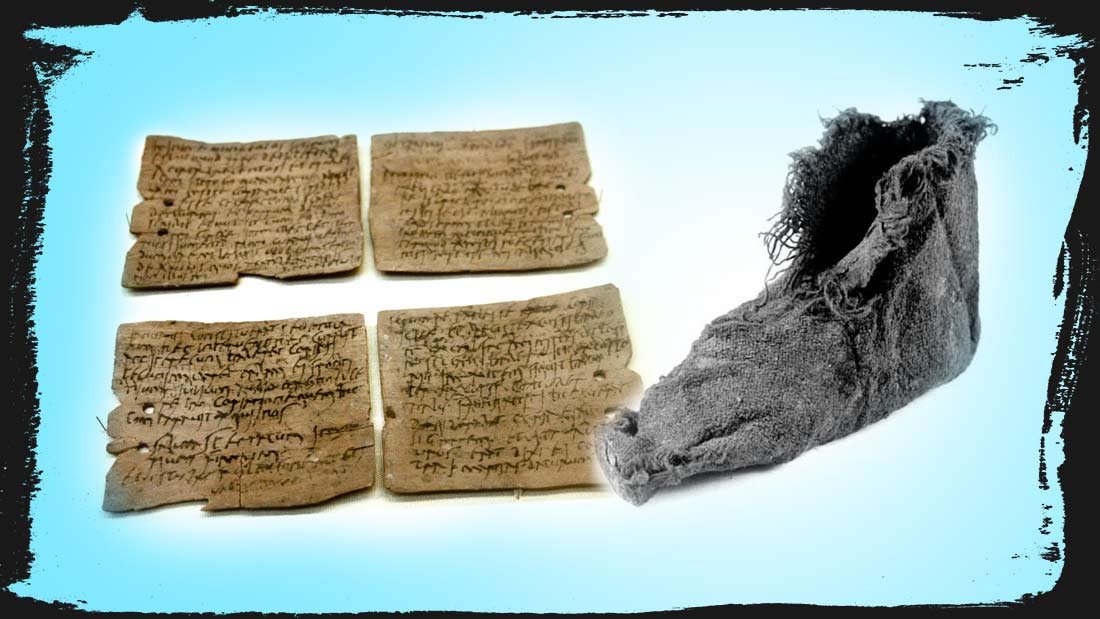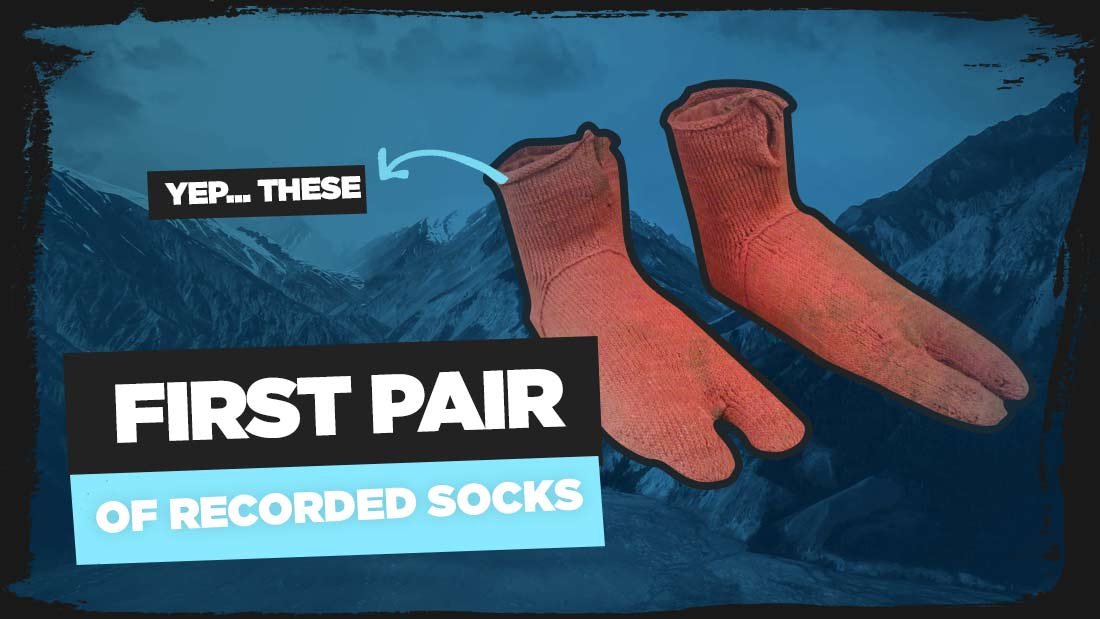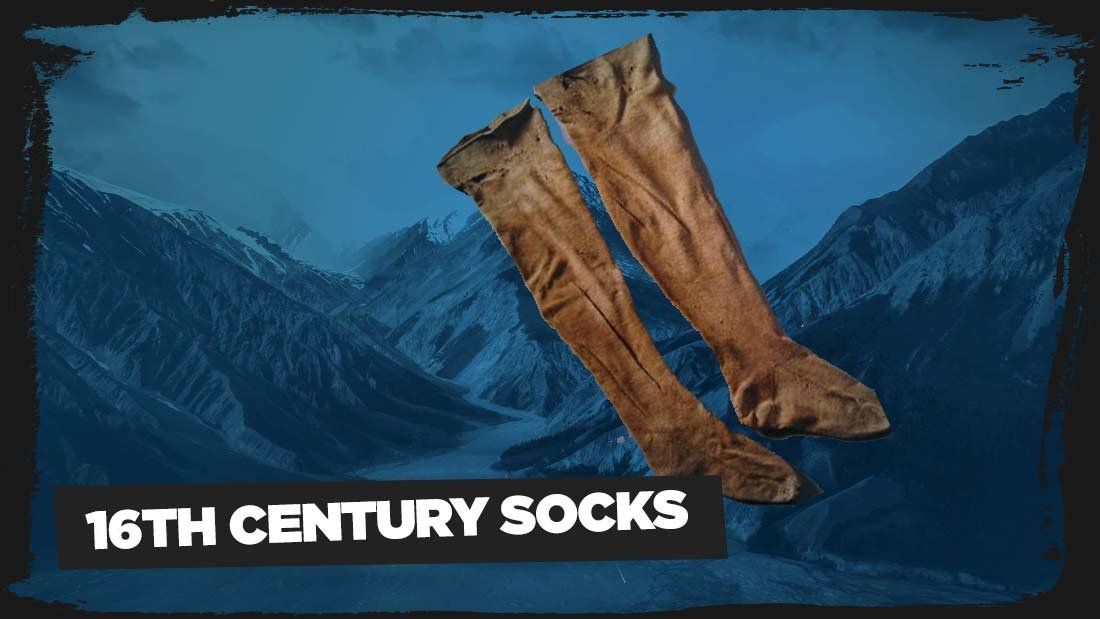Todays Topic: When were Socks invented?

Contents
As producers of high quality waterproof hiking socks, we thought that today we would try to enlighten people and answer the question of when were socks invented?
It’s not exactly the most philosophical of questions, but it’s one of those useful general knowledge topics: fashion & history, and who knows…this may even pop up in a pub quiz sometime and you’ll be able to say yep! I know that shit! 😉
So, when were socks invented? This article takes you through the advent and evolution of socks to the practical and stylish footwear accessory that we have come to know today.
The History and Evolution of Socks

This might come as a surprise to you but socks are probably the oldest form of clothing that is still being worn today. Socks have actually been around since the Stone Ages and the caveman started wearing versions of what we have today.
They have had a pretty long and wild ride throughout history.
For a long time, they were not easy to come by; in fact, they used to be reserved for the rich and noble in society, being made from fine cottons and silks.
Let us now take a trip down memory lane and look at the evolution of socks from the ancient civilisations to what we currently have….
The Beginning

Dating back to the Stone Ages, the first form of socks that early man wore was most likely unrecognisable in appearance to the pair you have on your feet today.
There haven’t been any socks leftover from that period; however, cave paintings, ancient drawings, and archeological findings have given us a clue of what and how they might have looked like.
From what has been found, it seems like these original socks were made from animal skins and furs tied around the ankle.
These were meant to protect the caveman from thorns and thistles since he was walking barefoot, as well as protecting them from the bitter cold.
Fast forward to a couple of thousand years before the 8th century BC and this is where we find the first mention of socks in writing. In his poem, ‘Works and Days”, the Greek poet Hesiod alludes to “piloi”- a form of sock made using matted animal fur and worn under the sandals.

In the later days, people would wrap strips of leather or woven fabric around their feet as recorded in Roman mythology. Around 2nd Century BC, pieces of fabric were sewed together to make fitted socks. These were known as “udones” and they are the closest thing in appearance to what we have today.
The first wool socks were discovered at a place called Vindolanda in Northumbria, dating back to the 2nd Century AD. These child-sized socks were meant to shield people against the rough British weather. There are even Roman tablets that were found on the site with inscriptions of “send more socks”.

By the time the 5th Century AD came along, holy people in various European nations started wearing a type of sock called “puttees” which were a symbol of purity.
The first pair of socks recorded..

According to Wikipedia, the first pair of socks recorded/recovered in a good condition (on Display at the Victoria and Albert museum) were made using a technique known as “naalbinding” and dates all the way back to 300-500 AD during the time of the Egyptians.
It was discovered at Oxyrhynchus on the River Nile and featured split toes that enabled them to be worn with sandals.
The Middle Ages

In the middle ages, stockings and pants formed a single item of clothing. Later on, people started changing the stocking more frequently because being closer to the ground ensured that they got dirty faster. Ultimately, the stocking became an independent item of clothing.
The Middle Ages also saw the extension of the length of trousers as the sock evolved to a tight and brightly-coloured cloth that covered the lower part of the leg. Given that socks didn’t come with elastic bands at this time, garters were instead placed over the top prevent them from sliding down.
As the breeches got shorter, socks grew longer and costlier.
By the year 1000, woven and knit socks were a status symbol of nobility in many regions of Europe.
Initially, they bore a closer resemblance to leggings until the 12th century when feet were added to them.

Even though working people in Europe were knitting their homespun stocking and socks by the end of the 12th Century, those worn by noblemen were vastly superior. These were made from higher-quality woven cloth with a bias cut.
Italian and French aristocracies paved the way by the 15th Century with their hand-knit silk stockings. The stretchy silk fabric enhanced movement and showed off a shapely leg, which was deemed more advantageous than the other socks.
Meanwhile, aristocrats in Britain started following suit and the knitted silk socks were all the rage among the fashionable elite in the country. Towards the end of the 1400s, breeches and hand-knit hosiery were joined to make a single garment that later came to be known as tights. These comprised colorful silk, wool, and velvet with a different color for each leg.
In the 16th century, hosiery was strictly regulated with stringent laws. The British City of London in 1566, used surveillance to make sure that no individuals were wearing the wrong socks anywhere in the city.
These laws were enforced by special sock police stationed at the London gates to check those coming in and going out.

The first knitting machine came into being in 1589; the brainchild of an English clergyman, William Lee. Queen Elizabeth I, after receiving black stockings from William, declined to grant him a patent, complaining that the stockings were too coarse for royal ankles.
Apparently, she didn’t like their feel and was worried that the machine would eventually take away jobs from the citizens. Fortunately, King Henri IV of France jumped on the opportunity of William’s invention and offered financial support as a result.

William made the move to Rouen, built a stocking factory and soon enough, the French were spreading the knitting loom across Europe. At the time, socks meant for the lower classes featured wool whereas those designed for noblemen were made using coloured silk.
With the industrial revolution, socks were cheaply produced and their appeal grew across European society.
You can still find many of the principles developed by William Lee in modern textile machinery being used today.
Socks Today
Over the years that followed, the sock fashion continued to evolve with respect to length, ranging from mid-calf and knee to mid-thigh. In addition to embroidery at the top, the sock fashion grew to include more colourful garments with stripes and decorations.
Towards the end of the 17th century, people were more attracted to cotton as a material for making garments, including socks.
As the trousers grew longer and longer, so did the socks become shorter. The word “socks” is essentially used as a short form of what the older generation used to call “stockings”.
The next notable occurrence in the history of socks happened in 1938 when nylon was invented. The elasticity and strength of nylon-cotton blend socks served as a step forward in manufacturing. To this day, you can still find people using nylon socks.
As time went by, elastane was used to give the blend extra flexibility so that it could be worn by a wider range of foot sizes.
As far as style and looks are concerned, sock fashion has presided over several models that come and go, only to reappear after a couple of years.
For example, Argyle patterned socks, which were quite popular in the 20s are making a notable comeback to men’s fashion. Thanks to technological advances in manufacturing, cotton can now be dyed more accurately, making for bolder and colorful socks.

Striped socks have always remained a popular choice for both men and women, while you will come across socks featuring all manner of crazy and creative patterns on their design. Anything that has been conceived by human creativity can be found in the market today.
Furthermore, you’ll find socks designed for different uses, including various sporting activities, as well as those that are meant for different kinds of weather. Waterproof walking socks and thermal socks also exist for use in wet and cold environments.
Conclusion
The next time you come from work, I am sure you’ll give that wiggly and stinky pair of socks the respect it deserves after reading this article. Now that you have the down-low on how the socks you’re wearing came to be, it shouldn’t be a task to enlighten a friend who asks, “when were socks invented?”









